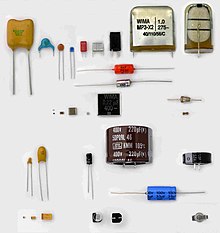Basic Electrical Components
Passive components
- cannot introduce net energy into the circuit
- cannot rely on a source of power, except for what is available from the (AC) circuit they are connected to
- cannot amplify (increase the power of a signal)
- may increase a voltage or current
Resistor
- restricts the flow of current in the circuit
- absorbs the electrical energy and degenerates it in the form of heat
- can vary or fixed resistances
The current flowing through a resistor is directly proportional to the voltage across the resistor terminals.
The relationship is represented by Ohm’s law.
Ohms law V=IR from this equation, we can get I=V/R
Where, ‘V’ is the Potential difference of the conductor, ‘I’ is the current through the conductor and ‘R’ is the resistance of the conductor.
Capacitor
- a two terminals component
- made from two conductive plates with an insulator between them
- stores electrical energy
- maintains the charge even after getting disconnected

They are used for filtering power supply lines, tuning resonant circuits, and for blocking DC voltages while passing AC signals, among numerous other uses.
Inductor
- a two-terminal passive component
- made from two conductive plates with an insulator between them
- stores electrical energy in the form of magnetic energy

When a current flows through the coil from the left side to the right side – the coil produces a magnetic field in the clockwise direction
Transformer
- consists of two coils of wire
- changes the current and voltage levels easily
- increase (step-up) or decrease(step-down) AC voltages

The transformer works on the principle of Faraday’s law of electromagnetic induction, that is, mutual inductance between two circuits, that is linked by a common magnetic flux
Fuse
- a material or a piece of wire
- protects components from destruction due to excessive current flowing through them

When the fuse melts due to overflow of current then, the element of the fuse absorbs some energy
Diode/LED (Light Emitting Diode)
- made from semiconductor material
- allows current to flow in one direction
- blocks the current which tries to go against the flow in a wire
- LED emits light at a particular frequency

LEDs are used in numerous applications like keyboards, hard disks, TV remote controls, often as status indicators in computers as well as battery-operated electronics Transistors

Transistors
- consists of three terminals
- made of semiconductor material
- controls the flow of voltage or current
- acts as a switch for electronic signals

In Transistors, the base terminal is responsible for activating the transistor, emitter terminal is the negative lead and collector terminal is the positive lead
Active components
- rely on a source of energy (usually from the DC circuit)
- usually can inject power into a circuit
- includes amplifying components
More on the subject
- http://therestartproject.org/wiki/Basic_electronic_components
- https://en.wikipedia.org/wiki/Electronic_component
- http://www.pcguide.com/intro/fun/components-c.html
- http://www.bbc.co.uk/schools/gcsebitesize/design/electronics/componentsrev1.shtml